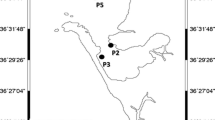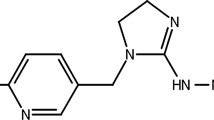Abstract
The main aim of the toxicity test is to be able to measure toxicity in organisms, and therefore to assess whether a nationally or internationally preset standard is met. LC50 values (median lethal concentration that kills 50% of the population at a given time) or LT50 values (median lethal time in which 50% of the test species died) provide useful information for risk assessment. However, extrapolating laboratory data to actual field conditions is difficult because of changing environmental factors like temperature and salinity. LC50 copper data for Hediste diversicolor treated multifactorially show the plasticity of the worm to environmental variables. Increasing temperature, 12 to 22°C, and increasing salinity, 7.6 to 30.5‰ reduced toxicity of copper to the worms without sediment. In the presence of sediment increasing temperature and increasing salinity increased toxicity of copper to the worms.
Similar content being viewed by others
References
Bryan, G. W.: 1976, ‘Some Aspects of Heavy Metal Tolerance in Aquatic Organisms’, In: Effects of Pollutants on Aquatic Organisms, Lockwood, A. P. M. (ed.), Cambridge University Press, pp. 7–14.
Bryant V., McLusky D. S., Roddie K. and Newberry D. M.: 1984, ‘Effects of Temperature and Salinity on the Toxicity of Chromium to Three Estuarine Invertebrates (Corophium volutator, Macoma balthica, Nereis Diversicolor)’, Mar. Ecol. Prog. Ser. 20, 137–149.
Cairns J.Jr. and Sheir A.: 1957, ‘The Effects of Temperature and Hardness of Water Upon the Toxicity of Zinc to the Common Bluegill Sunfish (Leopomis Macrochirus, Raf.)’, Notulae Natur. (Philadelphia) 299, 1–12.
Dales R. P.: 1950, ‘The Reproduction and Larval Development of Nereis diversicolor (O. F. Muller)’, J. Mar. Biol. Ass. U.K. 29, 321–360.
Davies C. L. (ed.): 1967, Design and Analysis of Industrial Experiments 2nd. edition, Oliver and Boyd, Edinburgh-London, pp. 636.
Gameson, A. L. H. (ed.): 1982, ‘The Quality of the Humber Estuary. A Review of the Results of Monitoring 1961–1981’, Published by the Yorkshire Water Authority on behalf of the Humber Estuary Committee, pp. 88.
Hart B. T.: 1981, ‘Trace Metal Complexing Capacity of Natural Waters, A Review’, Environ. Technol. Lett. 2, 95–110.
Kinne O.: 1964, ‘The Effects of Temperature and Salinity on Marine and Blackish Water Animals, 11. Salinity and Temperature Combinations’, Oceanogr. Mar. Biol. Ann. Rev. 2, 281–339.
Litchfield J. T. Jr. and Wilcoxon F.: 1949, ‘A Simplified Method of Dose — Effect Experiments’, J. Pharmacol. Exptl. Theor. 96, 99–113.
Maciorowski H. D. and Clarke R. McV.: 1977, ‘Advantages and Disadvantages of Using Invertebrates in Toxicity Testing’, in: Aquatic Invertebrate Bioassays. Buikema A. L. Jr. and Cairns J. Jr. (eds.), ASTM, STP, 715 Philadelphia, pp. 36–47.
Ozoh, P. T. E.: 1986, ‘Studies on the Toxicity of Copper to Various Stages in the Life Cycle of Hediste (Nereis) diversicolor (O. F. Muller)’, Ph.D. Thesis, University of Hull pp. 127.
Ozoh, P. T. E.: 1990, ‘The Effects of Salinity, Temperature and Sediment on the Toxicity of Copper to Juvenile Hediste (Nereis) diversicolor (O. F. Muller)’, in Press, this journal.
Perkins E. J.: 1974, The Biology of Estuaries and Coastal Waters, Academic Press, London, pp. 678.
Renfro W. C.: 1973, ‘Transfer of Zinc-65 from Sediments by Marine Polychaetes Worms’, Mar. Biol. 21, 305–316.
Young J. S., Buschbom R. L., Curtisen J. M. and Joyce S. P.: 1979, ‘The Relationship Between the Copper Complexing Capacity of Sea Water and Copper Toxicity in Shrimp Zoeae’, Mar. Environ. Res. 2(4), 265–272.
Author information
Authors and Affiliations
Rights and permissions
About this article
Cite this article
Ozoh, P.T.E. The importance of adult Hediste (Nereis) diversicolor in managing heavy metal pollution in shores and estuaries. Environ Monit Assess 21, 165–171 (1992). https://doi.org/10.1007/BF00399685
Issue Date:
DOI: https://doi.org/10.1007/BF00399685




